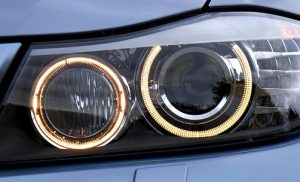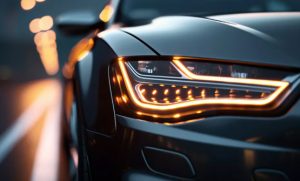Headlights have come a long way from simple incandescent bulbs housed in metal reflectors. Modern car lighting systems now combine advanced optics, precision engineering, and innovative materials to deliver maximum illumination without blinding oncoming drivers. Two key technologies — reflectors and projector lenses — play a central role in achieving this balance. Understanding how they work and differ can help car owners make smarter choices when upgrading or maintaining their lighting systems.

Evolution of Headlight Design
In the early days of automotive history, headlights were basic: parabolic reflectors with tungsten filaments that offered limited brightness and control. Over the decades, technology evolved through halogen, xenon (HID), and now LED and laser systems.
Today’s headlight assemblies combine optical science with digital control, where even the beam shape and intensity can be electronically adjusted. But at the core, two optical systems still dominate — reflector-based and projector-based headlights.
| Headlight Type | Main Light Source | Optical Element | Light Control Method |
|---|---|---|---|
| Reflector Headlight | Halogen / LED | Parabolic or Free-Form Reflector | Reflection of light into a defined beam |
| Projector Headlight | HID / LED / Laser | Lens + Shield | Projection of focused light beam through a lens |
Reflector Headlights: Simplicity and Efficiency
Reflector headlights are the more traditional of the two systems. They rely on a reflective bowl-shaped surface behind the bulb that bounces light forward in a specific pattern.
Key Components of a Reflector System:
-
Bulb: The light source (halogen, HID, or LED).
-
Reflective Surface: Typically aluminum-coated, shaped to direct the light beam.
-
Housing and Lens: Protects the components and diffuses the light output.
Advantages:
-
Compact and Cost-Effective: Fewer components and simpler design.
-
Lightweight: Ideal for vehicles prioritizing efficiency.
-
Easy Maintenance: Bulb replacement and alignment are straightforward.
Limitations:
-
Beam patterns are less controlled, which can cause glare if misaligned.
-
Light distribution can be uneven compared to projector systems.
-
Less suitable for high-intensity light sources like HID or laser.
To address these issues, modern multi-reflector or free-form reflector designs use computer-calculated surfaces that precisely shape the beam.
| Reflector Type | Description | Light Output Quality |
|---|---|---|
| Parabolic Reflector | Classic round shape | Broad but less focused beam |
| Free-Form Reflector | Faceted or curved surfaces | More controlled, even beam |
| Multi-Reflector | Multiple smaller surfaces | Balanced light distribution |
Projector Headlights: Precision and Power
Projector headlights represent a more advanced approach to lighting control. Instead of relying solely on reflection, they focus and project light through a lens, much like a movie projector.
Main Components of a Projector System:
-
Bulb or LED Module: The primary light source.
-
Reflector Bowl: Collects and directs light toward the lens.
-
Lens: Usually convex, focuses the light into a concentrated beam.
-
Cutoff Shield: Creates a sharp horizontal beam limit, preventing glare to oncoming traffic.
Advantages of Projector Headlights:
-
Sharper Cutoff Line: Prevents glare and improves safety for others on the road.
-
Better Focus and Range: Produces a longer and more uniform beam pattern.
-
Ideal for High-Intensity Lights: Especially HID and LED sources.
-
Modern Aesthetic: Sleeker design that enhances vehicle styling.
Disadvantages:
-
More expensive to produce and repair.
-
Requires precise alignment during installation.
-
The lens can accumulate dust or condensation, reducing light output if not sealed properly.
| Feature | Reflector Headlight | Projector Headlight |
|---|---|---|
| Beam Focus | Moderate | Very Sharp |
| Glare Control | Basic | Excellent |
| Brightness | Standard | High |
| Design Complexity | Simple | Complex |
| Ideal for HID/LED | Limited | Excellent |
| Maintenance | Easy | Moderate |
LED and Laser Lighting: New Era, Same Principles
While LED and laser technologies dominate modern premium vehicles, they still rely on reflector and projector principles.
-
LED Reflectors: Use multiple LEDs and precision-shaped reflectors to simulate the beam pattern of traditional lights.
-
LED Projectors: Integrate LED chips directly behind the lens, allowing adaptive beam control.
-
Laser Projectors: Use a laser source to excite phosphor, creating an ultra-bright light projected through lenses with extreme accuracy.
Adaptive Projector Systems
Modern vehicles now feature adaptive projector headlights, which automatically adjust their beam pattern based on driving conditions.
These systems can:
-
Dimming portions of the beam to avoid dazzling oncoming drivers.
-
Expanding coverage during cornering.
-
Focusing light farther at high speeds.
Maintenance and Care Tips
Even the best headlights require regular care to maintain optimal performance:
1. Check Alignment Regularly
Misaligned headlights — especially projectors — can cause glare or reduce visibility.
2. Keep Lenses Clean
Dirt or oxidation on the lens reduces beam clarity. Use headlight restoration kits if lenses appear cloudy.
3. Inspect Seals and Housings
Moisture ingress can damage reflectors and lenses, leading to dimming or uneven beams.
4. Use Quality Bulbs and Components
Low-quality bulbs may not match the optical design of your headlight system, causing poor performance.
5. Replace in Pairs
For balanced lighting, always replace bulbs or LED modules in pairs.
Choosing Between Reflector and Projector Headlights
| Driving Condition | Best Option | Reason |
|---|---|---|
| Urban, low-speed driving | Reflector | Wide, short-range beam ideal for city traffic |
| Highway or off-road driving | Projector | Long-range precision beam and better focus |
| Aesthetic and performance upgrade | Projector | Modern look and advanced light control |
If you are upgrading or replacing your car’s headlights, the best choice depends on your driving needs, budget, and vehicle compatibility.
The Future of Headlight Design

Automotive lighting is moving toward intelligent matrix systems, where hundreds of LEDs or micro-mirrors create adaptive beam patterns controlled by onboard cameras. Yet, even these futuristic systems build upon the fundamental principles of reflectors and lenses.
Whether you’re driving a classic car with halogen reflectors or a modern EV with adaptive LED projectors, proper design and alignment remain the cornerstone of effective illumination.
Conclusion
Reflectors and projector lenses are at the heart of modern headlight technology, balancing brightness, control, and safety. Reflector systems continue to offer simplicity and affordability, while projectors deliver superior performance, precision, and aesthetic appeal.
No matter your vehicle type, maintaining high-quality lighting components is vital for visibility and safety on the road. For the best selection of parts and accessories, you can Buy Car Lighting online — ensuring your headlights perform at their best in every driving condition.